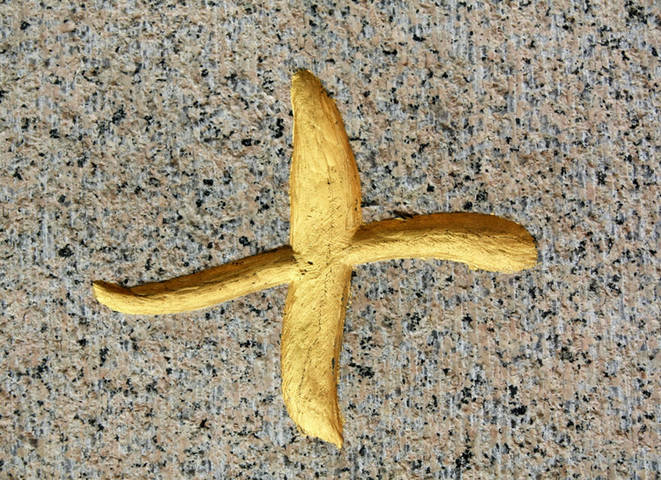24. The "Cross" Radical: 十 and ナ
In kanji, the 十 shape is widespread. But when it comes to the "cross" radical 十, that pervasiveness is deceptive. Relatively speaking, not that many Joyo kanji actually contain this radical.
Kanji Radicals That Don't Actually Contain 十
Even though a character may appear to contain a 十, that shape is likely part of a larger radical. Take 土 (radical 32: earth), for instance, as well as a host of radicals that include the 土 shape:
生 (radical 100: birth)
至 (radical 133: arriving)
赤 (radical 155: red)
走 (radical 156: running)
里 (radical 166: village)
青 (radical 174: blue)
One could easily (but mistakenly) spot a 十 in quite a few other radicals, as well, including these:
士 (radical 33: samurai)
巾 (radical 50: cloth)
干 (radical 51: dry)
廾 (radical 55: letter H)
支 (radical 65: branch)
斗 (radical 68: dots and cross), which also has a similar English nickname
木 (radical 75: tree)
用 (radical 101: use)
田 (radical 102: rice field)
缶 (radical 121: jar)
老 (radical 125: old) or its variant, 耂
Now that we've cleared up everything that's not the 十 radical, let's focus on what is.
The Shape-Shifting "Cross" Radical
The shape of the "cross" radical shifts in a few ways. It becomes short and fat in 直 (349: straight; to fix), where it's just a component, and it grows long and thin in 協 (461: cooperation), where it's the radical. These altered forms don't necessarily qualify as "variants"; they're just smushed!
Sometimes the bottom part of 十 curves to the left, becoming ナ, but the curve is often imperceptible. (In calligraphy, though, the curve is considered desirable.)
When the curve of ナ is more pronounced, this shape ceases to qualify as the "cross" radical! For instance, in 左 (22: left), the ナ represents a "left hand." Nelson notes that some dictionaries classify ナ as a variant of 十, but he refuses to do so.

Yomi and Meaning of the "Cross" Radical
Whatever the shape of the "cross" radical, it has just one yomi—namely, じゅう. That's identical to one on-yomi of the character 十 (33: ten).
The 十 radical means "10," just as the full character 十 does. But Henshall says this kanji initially meant "sewing needle." He believes that the radical 十 still means "needle" in this kanji, where this shape is just a component:
針 (905: needle)
Well, to be accurate, Henshall says the right side means "10" but literally means "needle." I'm not sure how to interpret that. I should note that Kanjigen doesn't associate 十 with "needle" at all in any situations. According to that dictionary, the right side of 針 provides the sound.
In a smattering of other kanji, 十 means "10," says Henshall. That's true in these characters, in which 十 is the on-duty radical:
協 (461: cooperation)
The left side acts phonetically to express "to gather" and "many." The three iterations of 力 collectively mean "strength." If you have "many people's strength," then you have "cooperation"!
博 (564: extensive; doctor)
The "cross" radical means "10," as well as "numerous" and "to acquire." The whole right side acts phonetically to express "big, extensive." Thus, this kanji came to mean "spreading and making numerous gains."
In two non-Joyo kanji that no one uses anymore, 十 also means "10" (not surprisingly):
廿 (にじゅう: twenty)
卅 (さんじゅう: thirty)
Nowadays, people write these two kanji as 二十 (にじゅう: twenty) and 三十 (さんじゅう: thirty), respectively. I like the idea of taking 十 and adding a vertical stroke for every unit of 10. It's an interesting twist on a tally mark (while also resembling the Roman numerals X, XX, and XXX, which offer a different slant on the 十 shape). Of course, 廿 doesn't work quite like a tally mark. Instead, its variant 廾 (にじゅう: twenty) does. But the radical in that case is 廾 itself!
The Etymology When 十 Doesn't Mean 10 or Needle
Several characters officially contain 十 as the on-duty radical, but etymologically those crosses have nothing to do with 10 or needles. In most cases, the shapes of the kanji have changed over the years and only acquired crosses over time. Take, for instance, these characters:
千 (47: thousand)
You would expect this kanji to contain a 10! But instead it combines "person" (亻) and "one" (一), says Henshall.
午 (110: noon; sign of the horse)
This came from a pictograph of a "pestle."
半 (195: half)
This breaks down as "split" + "cow." The kanji originally referred to butchering a cow by splitting it in half.
卒 (537: to graduate)
Long ago, this character had to do with clothing.
卓 (1553: table; eminent)
The etymology is obscure, but "10" and "needles" don't come into the picture.
卑 (1727: base, lowly, vile, vulgar, mean)
As essay 1727 shows, the etymology bears no connection to 10 or needles.
A Kanji Coincidence
One final note. As I gathered all this information, I listened to Jango, which plays songs somewhat randomly. Rage Against the Machine's "Killing in the Name" came on and seemed to last forever. (Wow, is that an angry song!) Anyway, coincidentally, the beginning is about crosses!
